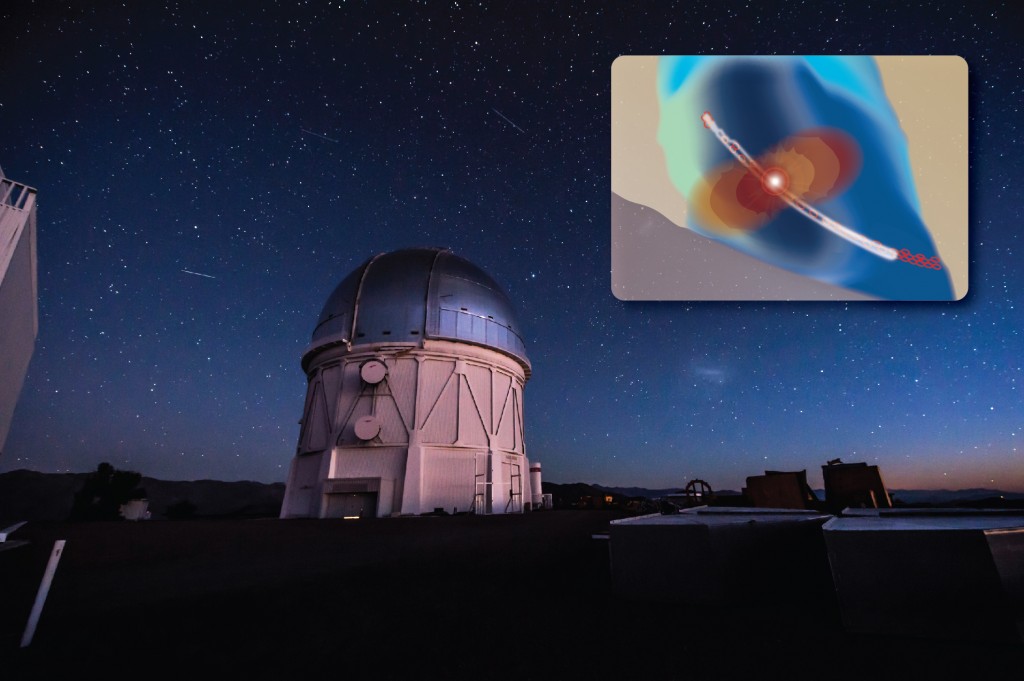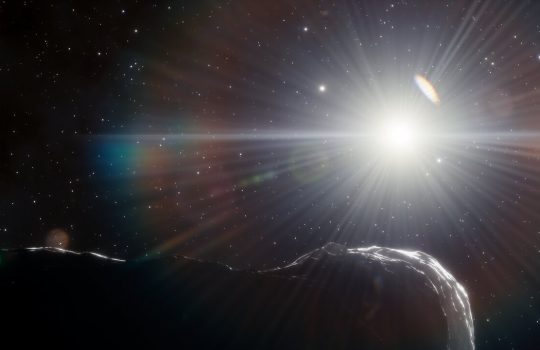The Dark Energy Camera, built to map the southern sky, sits inside a telescope in Chile. As its name suggests, it helps scientists to look for the origin of dark energy, the mysterious force that pushes the universe apart.
Now the camera has another job: It’s acting as eyes in the hunt for sources of gravitational waves.
A massive object, such as a star or a black hole, distorts the fabric of space — sort of the way a bowling ball bends the surface of a trampoline. If the object is accelerating, this distortion pulses outward in ripples traveling at the speed of light. These ripples are gravitational waves. But nobody has been able to record them so far.
“Gravitational waves are sort of the last prediction of Einstein’s that has yet to be experimentally verified,” said Rick Kessler, senior research associate at the University of Chicago.
Theory predicts that even puny humans make gravitational waves. But because our mass and accelerations are small, they’re too weak to notice. Most gravitational waves are. That’s why scientists haven’t directly detected them yet, although Albert Einstein predicted their existence 100 years ago.
There is indirect evidence that gravitational waves exist. It comes from a particular system of two neutron stars orbiting each other about 20,000 light-years away from Earth. Scientists have monitored the dizzying dance of these compact stars, together known as the Hulse-Taylor system, for more than 40 years.
Einstein predicted that gravitational waves carry energy away from a system. Removing energy from two orbiting objects shrinks their paths as if they were being lassoed together. The objects get closer and closer until, eventually, they merge in a cataclysmic collision.
Watching the stars in the Hulse-Taylor system gradually fall toward each other gives scientists indirect evidence that Einstein was right (again) — these neutron stars are losing energy in the form of gravitational waves, exactly as predicted.
“But we’re experimentalists,” Kessler said. “We want direct evidence.”
That’s where the Laser Interferometer Gravitational-wave Observatory comes in. Scientists built LIGO in an attempt to detect gravitational waves for the first time. And to find out more about the sources of potential gravitational waves, LIGO scientists are now coordinating their measurements with observations made by the Dark Energy Camera on the Blanco Telescope.

DES-GW is using the Dark Energy Camera in the Blanco Telescope in Chile to look for sources of gravitational waves. The red, orange and yellow areas the inset represent gravitational waves, and the bright light represents the source of these waves. The thin white arc illustrates a narrow area of sky where LIGO scientists believe a gravitational wave may have originated. Photo: Reidar Hahn; graphic: Diana Brandonisio
LIGO, funded by the National Science Foundation and other public and private institutions, has two detectors. One resides in Louisiana, the other in the state of Washington. They’re L-shaped, each outfitted with two perpendicular arms 2.5 miles long. Lasers shoot through the arms and bounce off mirrors that send them back to their source to combine and form what are known as interference patterns. Observing changes to these interference patterns due changes in space-time is key to directly detecting gravitational waves. That’s because gravitational waves ever so slightly squeeze and then stretch space, drawing separated points of matter a smidge closer together and then a smidge further apart.
The strongest space-time ripples are produced by violent cosmic events like the merging of two neutron stars (which will happen to the Hulse-Taylor system in 300 million years) or the collision of two black holes. Although these waves are actually quite feeble by the time they travel a few hundred million light-years to Earth, they will almost imperceptibly squeeze and stretch LIGO’s detector arms.
This faint manipulation will temporarily shorten or lengthen the detectors’ arms by 1,000 times less than the size of a proton. Changing the arm length alters the distance the lasers travel, which will show up as a slight shift in their interference pattern. Scientists can then read the interference pattern like a gravitational wave’s fingerprint, giving them direct evidence that space-time ripples exist.
“The detectors will tell us that a gravitational wave came from somewhere in a banana-shaped band of sky,” said Daniel Holz, associate professor at the University of Chicago who is on the LIGO experiment. “The problem is that the band is very large. It’s on the order of 400 times the size of the full moon.”
Although LIGO can point scientists in the general direction from which gravitational wave came, it can’t pick out the exact location of the source.
“That’s why they need the eyes of the Dark Energy Camera to go look in that general direction,” said Marcelle Soares-Santos, associate scientist at the U.S. Department of Energy’s Fermilab.
Members of the Dark Energy Survey, including Soares-Santos and other Fermilab scientists, have partnered with LIGO in the hunt for gravitational waves. They’re calling themselves the DES-GW group. Holz, who is also a member of DES-GW, said the team is a mixture of both gravitational wave and dark energy survey experts.
DES-GW will use the Dark Energy Camera to help LIGO search for the source of the gravitational waves it detects. Unlike most telescopes, the Dark Energy Camera is just the right size and has the right sensitivity to act as LIGO’s eyes. It can cover the banana-shaped area of the sky that LIGO looks at in 20 to 30 images.
When LIGO thinks it’s detected a gravitational wave, it will alert DES-GW collaborators, who will alert the Dark Energy Camera operators. LIGO and DES-GW have already joined forces and begun working together during the current season.
“With the Dark Energy Camera we’re trying to find an optical signature that accompanies the gravitational waves,” said Kessler, who is also a member of DES-GW.
“This is the frontier of science — we don’t really know what we’ll see,” Holz said. “But there’s an expectation that some systems will emit light at the same time as gravitational waves.”
Using the Dark Energy Camera to see this light, the optical signature of the gravitational waves’ source, could tell scientists more about the systems that produce them. This system may be made up of two neutron stars, two black holes or a neutron-black hole pair. And it would make history.
“We would be the first ones to directly detect gravitational waves and see light from the same event,” Soares-Santos said.
Soares-Santos is most excited about the potential of using this light as a tool to reconstruct the history of expansion of the universe, the same way supernovae are used today.
“There are lots of ifs and maybes,” Soares-Santos said of this possibility. “But at the same time, it’s exciting.”
Holz finds the most thrill in the prospect of surprise.
“Since we’ve never measured the universe in this way before, we just don’t know what’s out there,” Holz said. “That’s the real excitement.”



